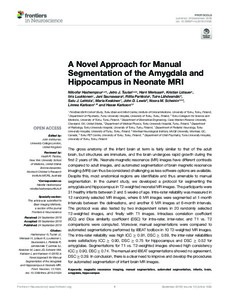A Novel Approach for Manual Segmentation of the Amygdala and Hippocampus in Neonate MRI
Kristian Lidauer; Satu J. Lehtola; Niloofar Hashempour; John D. Lewis; Iiris Luukkonen; Tuire Lähdesmäki; Maria Keskinen; Harri Merisaari; Hasse Karlsson; Jetro J. Tuulari; Riitta Parkkola; Jani Saunavaara; Linnea Karlsson; Noora M. Scheinin
A Novel Approach for Manual Segmentation of the Amygdala and Hippocampus in Neonate MRI
Kristian Lidauer
Satu J. Lehtola
Niloofar Hashempour
John D. Lewis
Iiris Luukkonen
Tuire Lähdesmäki
Maria Keskinen
Harri Merisaari
Hasse Karlsson
Jetro J. Tuulari
Riitta Parkkola
Jani Saunavaara
Linnea Karlsson
Noora M. Scheinin
FRONTIERS MEDIA SA
Julkaisun pysyvä osoite on:
https://urn.fi/URN:NBN:fi-fe2021042826359
https://urn.fi/URN:NBN:fi-fe2021042826359
Tiivistelmä
The gross anatomy of the infant brain at term is fairly similar to that of the adult brain, but structures are immature, and the brain undergoes rapid growth during the first 2 years of life. Neonate magnetic resonance (MR) images have different contrasts compared to adult images, and automated segmentation of brain magnetic resonance imaging (MRI) can thus be considered challenging as less software options are available. Despite this, most anatomical regions are identifiable and thus amenable to manual segmentation. In the current study, we developed a protocol for segmenting the amygdala and hippocampus in T2-weighted neonatal MR images. The participants were 31 healthy infants between 2 and 5 weeks of age. Intra-rater reliability was measured in 12 randomly selected MR images, where 6 MR images were segmented at 1-month intervals between the delineations, and another 6 MR images at 6-month intervals. The protocol was also tested by two independent raters in 20 randomly selected T2-weighted images, and finally with T1 images. Intraclass correlation coefficient (ICC) and Dice similarity coefficient (DSC) for intra-rater, inter-rater, and T1 vs. T2 comparisons were computed. Moreover, manual segmentations were compared to automated segmentations performed by iBEAT toolbox in 10 T2-weighted MR images. The intra-rater reliability was high ICC >= 0.91, DSC >= 0.89, the inter-rater reliabilities were satisfactory ICC >= 0.90, DSC >= 0.75 for hippocampus and DSC >= 0.52 for amygdalae. Segmentations for T1 vs. T2-weighted images showed high consistency ICC >= 0.90, DSC >= 0.74. The manual and iBEAT segmentations showed no agreement, DSC >= 0.39. In conclusion, there is a clear need to improve and develop the procedures for automated segmentation of infant brain MR images.
Kokoelmat
- Rinnakkaistallenteet [19207]
